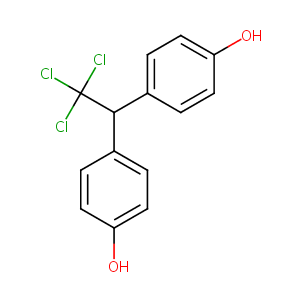Details of the Drug
General Information of Drug (ID: DMRPZD4)
| Drug Name |
HPTE
|
||||||||||||||||||||||
|---|---|---|---|---|---|---|---|---|---|---|---|---|---|---|---|---|---|---|---|---|---|---|---|
| Synonyms |
Hydroxychlor; HPTE; p,p'-Hydroxy-DDT; 2971-36-0; p,p'-HO-DDT; 2,2-Bis(4-hydroxyphenyl)-1,1,1-trichloroethane; 1,1,1-Trichloro-2,2-bis(4-hydroxyphenyl)ethane; 4,4'-(2,2,2-trichloroethane-1,1-diyl)diphenol; 2,2-Bis(p-hydroxyphenyl)-1,1,1-trichloroethane; 4,4'-(2,2,2-Trichloroethylidene)diphenol; 1,1-Bis(4-hydroxyphenyl)-2,2,2-trichloroethane; 1,1-Bis(p-hydroxyphenyl)-2,2,2-trichloroethane; p,p'-(2,2,2-Trichloroethylidene)diphenol; NSC 7045; 1,1,1-Trichloro-2,2-bis(p-hydroxyphenyl)ethane; Phenol, 4,4'-(2,2,2-trichloroethylid
|
||||||||||||||||||||||
| Indication |
|
||||||||||||||||||||||
| Drug Type |
Small molecular drug
|
||||||||||||||||||||||
| Structure |
 |
||||||||||||||||||||||
| 3D MOL is unavailable | 2D MOL | ||||||||||||||||||||||
| #Ro5 Violations (Lipinski): 0 | Molecular Weight (mw) | 317.6 | |||||||||||||||||||||
| Logarithm of the Partition Coefficient (xlogp) | 4.9 | ||||||||||||||||||||||
| Rotatable Bond Count (rotbonds) | 2 | ||||||||||||||||||||||
| Hydrogen Bond Donor Count (hbonddonor) | 2 | ||||||||||||||||||||||
| Hydrogen Bond Acceptor Count (hbondacc) | 2 | ||||||||||||||||||||||
| Chemical Identifiers |
|
||||||||||||||||||||||
| Cross-matching ID | |||||||||||||||||||||||
Molecular Interaction Atlas of This Drug
 Drug Therapeutic Target (DTT) |
|
|||||||||||||||||||||||||||||||||||||||||||||||||||||||||||||||||||||||
|---|---|---|---|---|---|---|---|---|---|---|---|---|---|---|---|---|---|---|---|---|---|---|---|---|---|---|---|---|---|---|---|---|---|---|---|---|---|---|---|---|---|---|---|---|---|---|---|---|---|---|---|---|---|---|---|---|---|---|---|---|---|---|---|---|---|---|---|---|---|---|---|---|
 Drug Off-Target (DOT) |
|
|||||||||||||||||||||||||||||||||||||||||||||||||||||||||||||||||||||||
| Molecular Interaction Atlas (MIA) | ||||||||||||||||||||||||||||||||||||||||||||||||||||||||||||||||||||||||
Molecular Expression Atlas of This Drug
| The Studied Disease | Discovery agent | |||||||||||||||||||||||
|---|---|---|---|---|---|---|---|---|---|---|---|---|---|---|---|---|---|---|---|---|---|---|---|---|
| ICD Disease Classification | N.A. | |||||||||||||||||||||||
|
||||||||||||||||||||||||
| Molecular Expression Atlas (MEA) | ||||||||||||||||||||||||
References
